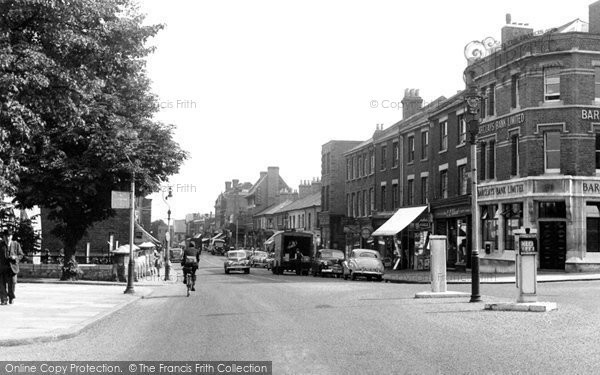Sainsburys, Brent Street
A Memory of Hendon.
Brent Street was a typical suburban or small town high street. There were no really large stores but a selection of individual shops. The range of shops was remarkable with several grocers, bakers, greengrocers, butchers, chemists, fish shops, newsagents and hairdressers. There was a drapers and ladies clothing store, a gentlemen's outfitters, furniture store, hardware shop, shoe shop, electrical store, dry cleaners and fish and chip shop.
In the distance in this photograph, on the right of Brent Street, the building with two prominent chimneys was Sainsburys, standing on the far corner of New Brent Street. Immediately behind the store was 'the debris', houses of New Brent Street and North Street bombed on 19 September 1940, in the early days of the Blitz, with 5 killed, 1 injured and 16 made homeless.
The Sainsburys building had two storeys above the shop, with further attic rooms with dormer windows, occupied by shop workers. There was a green wooden door on New Brent Street leading to a metal staircase to the shop roof and thus the accommodation entrance.
On entering Sainsburys there was a large semicircular meat counter to the right and beyond this a long, marble topped counter with a single shelf behind, selling butter, cheese and bacon. At the far end of the shop there was mahogany, half-circular accounts booth with impressive wooden, gothic column embellishment. There was a continuous marble topped counter running the whole length of the left-hand side, with multiple shelves behind and several serving positions, for the packaged grocery items. All the counters were faced with largely brown, patterned glossy tiles and the floor was of small, white mosaic tiles. Particularly in wet weather the floor had a dusting of sawdust.
The cheese and butter counter was always particularly fascinating. The cheeses were in large rounds from which wedges were cut to order using a wire attached to a wooden board. [In 1965 commissioning a radio station on a mountain top in Borneo, the Sapper Troop constructing the hutted accommodation departed in the helicopters carrying my party to the summit. I quickly discovered there were no cutting tools to complete the sheet metal roofing of one hut and sent a radio message to the Sapper Troop Commander, an old friend from Sandhurst days, seeking advice on the cutting of the light guage metal corrugated sheets. His response was succinct - 'like cheese'. With wire in the construction stores no further explanation was necessary!]
In the 1940's butter was also in bulk, in large squares. Using butter pats, sturdy wooden paddles, the assistants would make the blocks, normally of half pound size, to meet the customer's requirements. With great flourish the assistants would pat and square the butter, lifting it with the paddles to balance type scales to check the weight. Each time there was a need to add to or remove butter from the block, to achieve the required weight, there would be further pounding and squaring using the pats. On the grocery counter there were many commodities in bulk, such as lentils or currants, which would be scooped into bags to meet the customer's requirements. The bags were of a stiff, blue paper and again it was with a flourish that the assistants would drop the bag on the counter, to pack the contents down, and then rapidly fold the top with neat, sharp creases to form a tight seal.
The drapers and ladies clothing shop, standing on the opposite corner of New Brent Street to Sainsburys, was on two floors and it had an overhead wire cash handling system. Once a sale had been made, the assistant would place the bill and cash from the customer in a container, about two inches in diameter and nine inches long, which was clipped to the wire and 'fired' to a central cash desk by triggering a handle suspended above the serving position. Ultimately the container would be returned with the receipted bill and any change.
A trip would be made to some of the larger suburban shopping areas or 'the West End' of London for a greater range of shops. The favourite suburban shopping areas were Golders Green, about 3 miles away or Kilburn at about 9 miles. 'The West End' was taken to mean Oxford Street. At the top of Bell Lane was the well known bus fare stage known as 'The Bell', after the adjacent pub of the same name. It could serve as a terminus for some buses and they would be parked on two sides of the triangular island at the junction of Bell Lane and Brent Street. There was a frequent service from this bus stop to the terminus at Golders Green, with the 83, 125 and 240 bus as the principal routes. It was unusual to wait more than five or ten minutes for a bus. Occasionally it was possible to catch an additional service, one of the buses terminated at 'The Bell' or a No. 13 en route from Hendon Bus Station to start its main route from Golders Green to Aldwych. When travelling to or from the West End, catching a No 13 outbound or inbound to Hendon Bus was particularly welcomed because this saved a change of buses at Golders Green.
Add your comment
You must be signed-in to your Frith account to post a comment.
Add to Album
You must be signed in to save to an album
Sign inSparked a Memory for you?
If this has sparked a memory, why not share it here?




Comments & Feedback